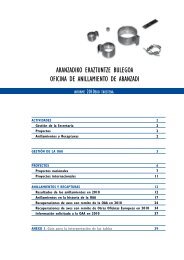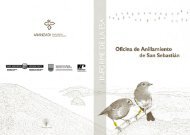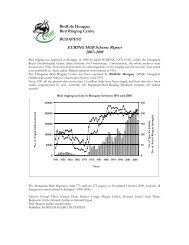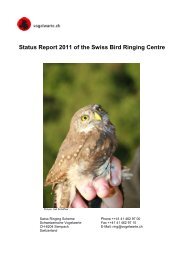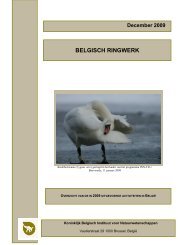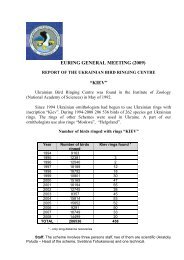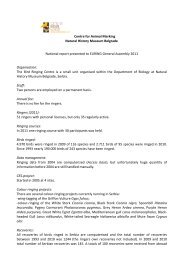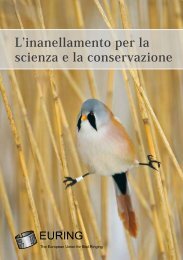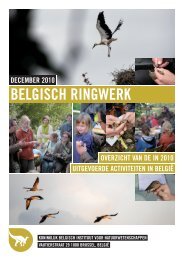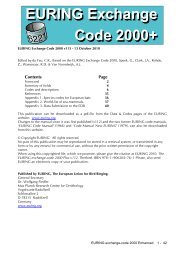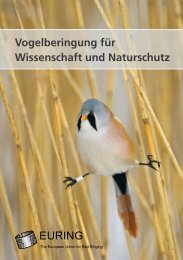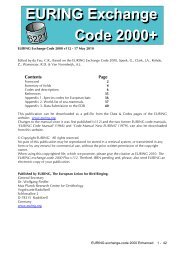Bird Ringing for Science and Conservation - The European Union ...
Bird Ringing for Science and Conservation - The European Union ...
Bird Ringing for Science and Conservation - The European Union ...
- No tags were found...
Create successful ePaper yourself
Turn your PDF publications into a flip-book with our unique Google optimized e-Paper software.
<strong>Bird</strong> <strong>Ringing</strong> <strong>for</strong> <strong>Science</strong> <strong>and</strong> <strong>Conservation</strong><br />
<strong>Bird</strong> <strong>Ringing</strong> <strong>for</strong> <strong>Science</strong> <strong>and</strong> <strong>Conservation</strong><br />
Dispersal <strong>and</strong> population persistence<br />
<br />
<br />
0.1<br />
<br />
<br />
<br />
<br />
<br />
<br />
<br />
Most <strong>European</strong> bird populations live in<br />
habitats that are highly fragmented as a<br />
result of human activities. <strong>The</strong> dynamics<br />
<strong>and</strong> genetic diversity of populations inhabiting<br />
such l<strong>and</strong>scapes are often critically dependent<br />
on dispersal patterns, as well as<br />
on reproduction <strong>and</strong> survival within habitat<br />
patches. To gain a better underst<strong>and</strong>ing<br />
of how to manage these l<strong>and</strong>scapes <strong>for</strong><br />
birds we need in<strong>for</strong>mation on dispersal derived<br />
from bird-ringing.<br />
Two main types of dispersal are recognized<br />
in population ecology. Natal dispersal<br />
refers to movements between the place<br />
of birth <strong>and</strong> that of first breeding, while<br />
breeding dispersal refers to movements<br />
between subsequent breeding attempts.<br />
<strong>The</strong>re are two complementary ways of<br />
studying dispersal using bird ringing. Markrecapture<br />
<strong>and</strong> mark-resight ing data can be<br />
used to measure dispersal within local populations,<br />
or between populations occupying<br />
a limited number of colonies or habitat<br />
patches. <strong>The</strong>se studies provide a high resolution<br />
picture of local movements but may<br />
miss long-distance ones. In contrast, analyses<br />
of ring recoveries provide a broad overview<br />
of dispersal patterns including longdistance<br />
movements, but may lack fine<br />
detail. In both of these methods it is important<br />
to control <strong>for</strong> variation in recording<br />
ef<strong>for</strong>t.<br />
Current knowledge of natal <strong>and</strong> breeding<br />
dispersal is based on analyses of ringing<br />
data. For most species natal dispersal is<br />
greater than breeding dispersal, <strong>and</strong> species<br />
with higher natal dispersal also tend to<br />
move further between subsequent breeding<br />
years. Average (geometric mean) dispersal<br />
distances vary greatly between species.<br />
For example, in Britain <strong>and</strong> Irel<strong>and</strong><br />
Blackcaps have an average natal dispersal<br />
distance of 17,5 km while House Sparrows<br />
move an average of only 0,2 km between<br />
their natal <strong>and</strong> breeding sites. Dispersal<br />
patterns are influenced mainly by the ecological<br />
characteristics of individual species,<br />
with those occupying more restricted <strong>and</strong><br />
patchy habitats showing greater dispersal.<br />
Scarcer species generally occupy more restricted<br />
<strong>and</strong> patchy habitats <strong>and</strong> this results<br />
in a negative relationship between dispersal<br />
<strong>and</strong> abundance. For similar reasons, dispersal<br />
is greater amongst birds occupying<br />
wetl<strong>and</strong> habitats. Dispersal is also greater<br />
in migrants than in residents, presumably<br />
because of the opportunities <strong>for</strong> the<br />
<strong>for</strong>mer to explore new areas. <strong>The</strong>re is much<br />
scope to explore such patterns further using<br />
data from the EURING databank.<br />
Natal dispersal<br />
distances of Song<br />
Thrushes measured<br />
using ring recoveries<br />
from Britain<br />
<strong>and</strong> Irel<strong>and</strong>.<br />
<strong>The</strong>re is now increasing evidence from<br />
fieldwork <strong>and</strong> mathematical modelling<br />
that frequencies of occurrence <strong>and</strong> densities<br />
of many bird species are lower within<br />
habitat fragments than in large areas of<br />
continuous habitat. For example, a study<br />
in Northern Belgium found that Nuthatch<br />
densities in <strong>for</strong>est fragments were about<br />
half those in continuous areas of <strong>for</strong>est. In<br />
this species, dispersal distances are larger<br />
<strong>and</strong> territory vacancies are filled more<br />
slowly in fragments than in continuous<br />
habitat. Furthermore, areas where most<br />
of the habitat is fragmented act as sinks,<br />
with populations only being maintained by<br />
immigration from more continuous habitat.<br />
In order to manage populations within<br />
fragmented l<strong>and</strong>scapes it is vital to underst<strong>and</strong><br />
these relationships between population<br />
density, habitat quality <strong>and</strong> dispersal.<br />
Underst<strong>and</strong>ing dispersal is equally important<br />
<strong>for</strong> the conservation of colonial species<br />
such as seabirds, where immigration<br />
<strong>and</strong> emigration are key determinants of<br />
colony size.<br />
Dispersal also has important implications<br />
<strong>for</strong> the maintenance of genetic diversity<br />
within populations, <strong>and</strong> <strong>for</strong> rates of evolution<br />
in changing environments. In most<br />
bird species the greater natal dispersal of<br />
females compared to males helps to reduce<br />
inbreeding depression. A study of colourmarked<br />
Great Reed Warblers in Sweden<br />
found that low genetic variation <strong>and</strong> the<br />
occurrence of inbreeding depression were<br />
associated with restricted dispersal <strong>and</strong><br />
with a lack of any dispersal difference between<br />
males <strong>and</strong> females. <strong>The</strong>se genetic<br />
studies further emphasise the importance<br />
of improving our underst<strong>and</strong>ing of dispersal,<br />
which remains poor relative to that of<br />
other demographic processes. Large-scale<br />
studies of marked birds should <strong>for</strong>m an important<br />
part of this research ef<strong>for</strong>t.<br />
Alain Saunier<br />
<br />
<br />
<br />
<br />
<br />
<br />
<strong>The</strong> relationship between average natal<br />
dispersal distance <strong>and</strong> population size<br />
<strong>for</strong> 75 species. More abundant species<br />
generally occupy a wider range of habitats<br />
<strong>and</strong> need to move less far in order<br />
to find potential nesting sites.<br />
<strong>The</strong> Nuthatch is a good example of a<br />
species where patch occupancy in fragmented<br />
woodl<strong>and</strong> habitats is influenced<br />
by dispersal.<br />
after Paradis et al. 1998<br />
22<br />
23



